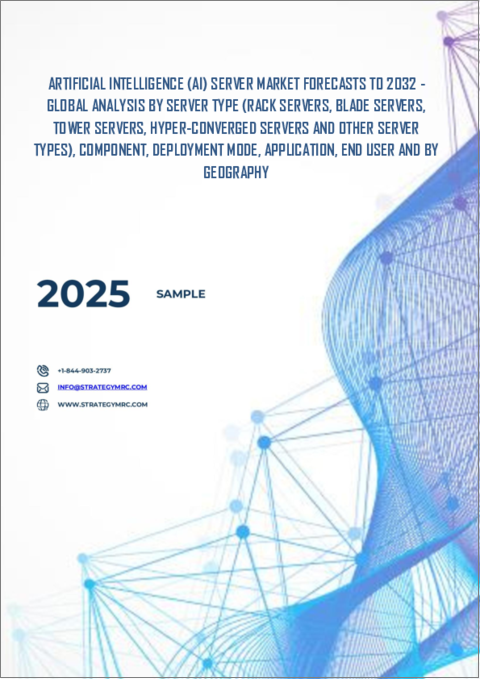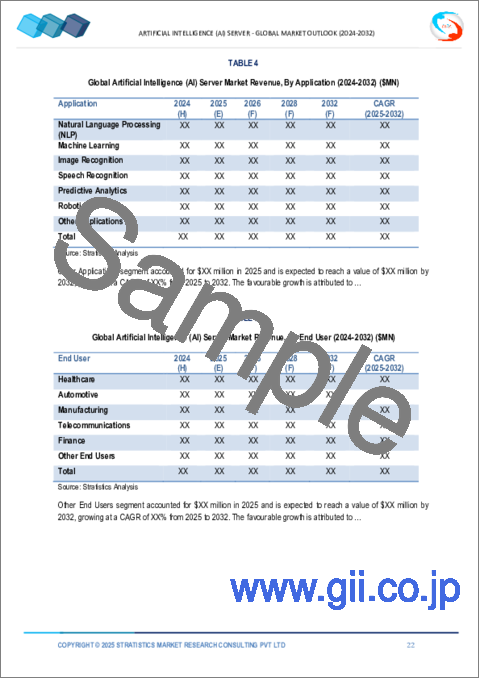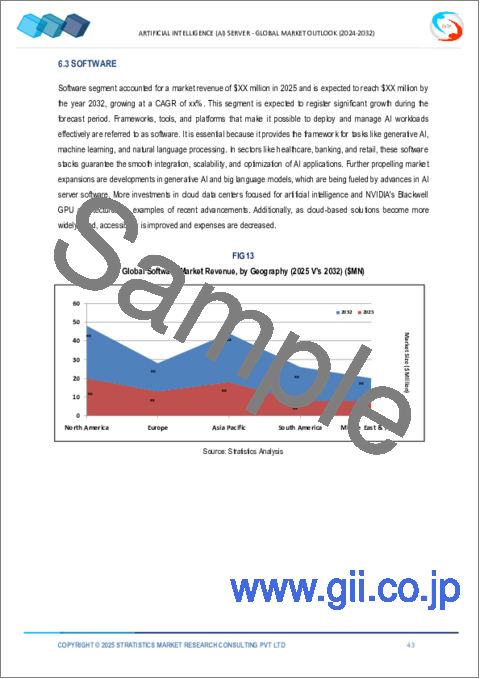|
|
市場調査レポート
商品コード
1636714
人工知能(AI)サーバー市場の2030年までの予測: サーバータイプ別、コンポーネント別、展開モード別、用途別、エンドユーザー別、地域別の世界分析Artificial Intelligence Server Market Forecasts to 2030 - Global Analysis By Server Type, Component, Deployment Mode, Application, End User and By Geography |
||||||
カスタマイズ可能
|
|||||||
| 人工知能(AI)サーバー市場の2030年までの予測: サーバータイプ別、コンポーネント別、展開モード別、用途別、エンドユーザー別、地域別の世界分析 |
|
出版日: 2025年01月01日
発行: Stratistics Market Research Consulting
ページ情報: 英文 200+ Pages
納期: 2~3営業日
|
- 全表示
- 概要
- 図表
- 目次
Stratistics MRCによると、世界の人工知能(AI)サーバー市場は2024年に345億8,000万米ドルを占め、予測期間中のCAGRは36.2%で成長し、2030年には4,352億6,000万米ドルに達すると予測されています。
人工知能(AI)サーバーは、機械学習、深層学習、データ分析などのAIワークロードをサポートし、高速化するために設計された特殊なコンピューティングシステムです。通常、複雑なアルゴリズムや大規模なデータセットを処理するために、高性能プロセッサ、大容量メモリ、強力なグラフィック・プロセッシング・ユニット(GPU)を備えています。これらのサーバーは、迅速なモデル学習、推論処理、リアルタイムのAI主導型意思決定のサポートを可能にし、様々な産業で重要な役割を担っています。
Science Directの調査論文によると、AIサーバーは2023年にサーバー市場全体の約23%を占めています。
クラウドベースのAIサービスへのシフトの高まり
クラウドベースのAIサービスへのシフトが進んでいる背景には、拡張性、柔軟性、コスト効率に優れたAIソリューションに対する需要の高まりがあります。クラウドプラットフォームにより、企業はオンプレミスのインフラを必要とせずに強力なAIモデルとコンピューティングリソースにアクセスできるようになり、設備投資を削減できます。このシフトは、より迅速な展開、高い可用性、強化されたコラボレーションを提供することで、さまざまな分野でのAI採用を加速します。クラウド環境はAI技術の急速な進歩を促進し、AIサーバー市場拡大のための活発なエコシステムを作り出しています。
データ・プライバシーとセキュリティへの懸念
AIサーバーにおけるデータプライバシーとセキュリティの懸念は、個人情報、金融情報、健康情報など、AIシステムによって処理される膨大な量の機密データから生じる。データ侵害、不正アクセス、AI主導の洞察の悪用の可能性は、個人と組織にリスクをもたらします。こうした懸念は、企業や政府が規制上の制限やコンプライアンス・コスト、消費者の不信に直面する可能性があり、AIサーバー市場の成長を妨げます。
5Gネットワークの展開
5Gは、自律走行車、スマートシティ、IoTデバイスなど、AIを搭載したシステムによって生成される大規模データセットのリアルタイム処理を可能にします。この加速された接続性により、AIサーバーはより迅速な意思決定、より深い洞察、より効率的な運用を実現できるようになります。5Gにより、エッジコンピューティングと高性能AIサーバーの需要は拡大し、企業は低遅延のAIタスクをサポートする強力なインフラを必要とするため、市場の成長を後押しし、ヘルスケア、自動車、製造業などの業界で新たなアプリケーションを可能にします。
高い初期投資とメンテナンスコスト
AIサーバーの初期投資と保守コストが高いのは、強力なプロセッサー、GPU、大容量ストレージ・システムなどの高度なハードウェア・コンポーネントが必要なためであり、これらの開発と実装にはコストがかかります。さらに、これらのサーバーを維持するには、熟練した人材、頻繁なソフトウェアの更新、インフラのアップグレードが必要であり、継続的なコストの一因となっています。このような要因により、AIサーバー市場の成長が阻害される可能性があります。
COVID-19の影響
COVID-19の流行は、企業がデジタルトランスフォーメーションの強化、プロセスの自動化、オペレーションの最適化を求めたため、人工知能(AI)サーバーの需要を加速させました。リモートワーク、eコマース、ヘルスケア・アプリケーションへの依存度が高まったことで、データ処理ニーズが急増し、AIサーバーの採用が促進されました。しかし、パンデミック(世界的大流行)時にはサプライチェーンの混乱とチップ不足が発生し、一時的に生産と供給が妨げられ、市場の成長が鈍化しました。こうした課題にもかかわらず、AI主導のソリューションに向けた全体的な動向は引き続き良好でした。
予測分析分野は予測期間中最大になる見込み
予測分析分野は、予測期間を通じて最大の市場シェアを確保すると予測されています。AIサーバーは、膨大な量の履歴データやリアルタイムデータを処理して将来の動向や行動を予測することで、予測分析において重要な役割を果たします。より迅速なデータ分析と意思決定精度の向上により、AIサーバーは予測モデルを強化し、企業が業務を最適化し、リスクを低減し、競争市場において成長を促進することを可能にします。
予測期間中、通信分野のCAGRが最も高くなる見込み
通信分野は予測期間中、最も高いCAGRが見込まれます。通信では、AIサーバーはネットワーク管理の最適化、顧客サービスの向上、予知保全の強化に使用されます。これらのサーバーは、ネットワーク運用からの大量のデータを処理し、リアルタイムの監視、異常検知、自動意思決定を可能にします。AIサーバーはチャットボットやバーチャルアシスタントをサポートし、顧客エンゲージメントを向上させ、ルーチンタスクやトラブルシューティングを自動化することで通信会社の運用コストを削減します。
最大のシェアを占める地域
アジア太平洋地域は、AI技術の進歩やヘルスケア、自動車、金融などの分野での採用増加により、予測期間中に最大の市場シェアを記録すると予想されます。中国、日本、韓国、インドなどの国々は、製造、研究、政府イニシアチブなどの産業におけるAIサーバーの高い需要を背景に、市場に大きく貢献しています。この地域のデジタルインフラの拡大とAI研究への旺盛な投資が市場を促進しています。
CAGRが最も高い地域:
北米は、強力な技術的進歩とAI研究への大規模な投資により、予測期間中に最も高いCAGRを記録すると予想されます。特に米国は、ハイテク大手やクラウドサービスプロバイダーがAIのイノベーションと展開をリードしており、市場の主要な牽引役となっています。同地域の強固なデジタルインフラ、AIを活用したソリューションの重視、AIイニシアティブに対する政府の支援が市場成長に寄与しています。
無料のカスタマイズ提供:
本レポートをご購読のお客様には、以下の無料カスタマイズオプションのいずれかをご利用いただけます:
- 企業プロファイル
- 追加市場プレイヤーの包括的プロファイリング(3社まで)
- 主要企業のSWOT分析(3社まで)
- 地域セグメンテーション
- 顧客の関心に応じた主要国の市場推計・予測・CAGR(注:フィージビリティチェックによる)
- 競合ベンチマーキング
- 製品ポートフォリオ、地理的プレゼンス、戦略的提携に基づく主要企業のベンチマーキング
目次
第1章 エグゼクティブサマリー
第2章 序文
- 概要
- ステークホルダー
- 調査範囲
- 調査手法
- データマイニング
- データ分析
- データ検証
- 調査アプローチ
- 調査情報源
- 1次調査情報源
- 2次調査情報源
- 前提条件
第3章 市場動向分析
- 促進要因
- 抑制要因
- 機会
- 脅威
- 用途分析
- エンドユーザー分析
- 新興市場
- COVID-19の影響
第4章 ポーターのファイブフォース分析
- 供給企業の交渉力
- 買い手の交渉力
- 代替品の脅威
- 新規参入業者の脅威
- 競争企業間の敵対関係
第5章 世界の人工知能(AI)サーバー市場:サーバータイプ別
- ラックサーバー
- ブレードサーバー
- タワーサーバー
- ハイパーコンバージドサーバー
- その他のサーバータイプ
第6章 世界の人工知能(AI)サーバー市場:コンポーネント別
- ハードウェア
- プロセッサ
- メモリ
- ネットワーク機器
- 電源ユニット
- ソフトウェア
- AIフレームワーク
- オペレーティングシステム
- AI開発ツール
第7章 世界の人工知能(AI)サーバー市場:展開モード別
- オンプレミス
- クラウドベース
第8章 世界の人工知能(AI)サーバー市場:用途別
- 自然言語処理(NLP)
- 機械学習
- 画像認識
- 音声認識
- 予測分析
- ロボット工学
- その他の用途
第9章 世界の人工知能(AI)サーバー市場:エンドユーザー別
- ヘルスケア
- 自動車
- 製造業
- 通信
- ファイナンス
- その他のエンドユーザー
第10章 世界の人工知能(AI)サーバー市場:地域別
- 北米
- 米国
- カナダ
- メキシコ
- 欧州
- ドイツ
- 英国
- イタリア
- フランス
- スペイン
- その他欧州
- アジア太平洋
- 日本
- 中国
- インド
- オーストラリア
- ニュージーランド
- 韓国
- その他アジア太平洋地域
- 南米
- アルゼンチン
- ブラジル
- チリ
- その他南米
- 中東・アフリカ
- サウジアラビア
- アラブ首長国連邦
- カタール
- 南アフリカ
- その他中東とアフリカ
第11章 主な発展
- 契約、パートナーシップ、コラボレーション、合弁事業
- 買収と合併
- 新製品発売
- 事業拡大
- その他の主要戦略
第12章 企業プロファイリング
- NVIDIA Corporation
- Intel Corporation
- IBM Corporation
- Google LLC
- Microsoft Corporation
- Amazon Web Services(AWS)
- Netweb Technologies India Limited
- Dell Technologies Inc.
- Cisco Systems Inc.
- Oracle Corporation
- Lenovo Group Limited
- Huawei Technologies Corporation
- Alibaba Group
- Baidu Inc.
- Qualcomm Incorporated
- Supermicro Computer, Inc.
- Micron Technology Inc.
- Fujitsu Limited
- HP Enterprise(HPE)
- Inspur Group
List of Tables
- Table 1 Global Artificial Intelligence (AI) Server Market Outlook, By Region (2022-2030) ($MN)
- Table 2 Global Artificial Intelligence (AI) Server Market Outlook, By Server Type (2022-2030) ($MN)
- Table 3 Global Artificial Intelligence (AI) Server Market Outlook, By Rack Servers (2022-2030) ($MN)
- Table 4 Global Artificial Intelligence (AI) Server Market Outlook, By Blade Servers (2022-2030) ($MN)
- Table 5 Global Artificial Intelligence (AI) Server Market Outlook, By Tower Servers (2022-2030) ($MN)
- Table 6 Global Artificial Intelligence (AI) Server Market Outlook, By Hyper-Converged Servers (2022-2030) ($MN)
- Table 7 Global Artificial Intelligence (AI) Server Market Outlook, By Other Server Types (2022-2030) ($MN)
- Table 8 Global Artificial Intelligence (AI) Server Market Outlook, By Component (2022-2030) ($MN)
- Table 9 Global Artificial Intelligence (AI) Server Market Outlook, By Hardware (2022-2030) ($MN)
- Table 10 Global Artificial Intelligence (AI) Server Market Outlook, By Processors (2022-2030) ($MN)
- Table 11 Global Artificial Intelligence (AI) Server Market Outlook, By Memory (2022-2030) ($MN)
- Table 12 Global Artificial Intelligence (AI) Server Market Outlook, By Networking Equipment (2022-2030) ($MN)
- Table 13 Global Artificial Intelligence (AI) Server Market Outlook, By Power Supply Units (2022-2030) ($MN)
- Table 14 Global Artificial Intelligence (AI) Server Market Outlook, By Software (2022-2030) ($MN)
- Table 15 Global Artificial Intelligence (AI) Server Market Outlook, By AI Frameworks (2022-2030) ($MN)
- Table 16 Global Artificial Intelligence (AI) Server Market Outlook, By Operating Systems (2022-2030) ($MN)
- Table 17 Global Artificial Intelligence (AI) Server Market Outlook, By AI Development Tools (2022-2030) ($MN)
- Table 18 Global Artificial Intelligence (AI) Server Market Outlook, By Deployment Mode (2022-2030) ($MN)
- Table 19 Global Artificial Intelligence (AI) Server Market Outlook, By On-Premise (2022-2030) ($MN)
- Table 20 Global Artificial Intelligence (AI) Server Market Outlook, By Cloud-Based (2022-2030) ($MN)
- Table 21 Global Artificial Intelligence (AI) Server Market Outlook, By Application (2022-2030) ($MN)
- Table 22 Global Artificial Intelligence (AI) Server Market Outlook, By Natural Language Processing (NLP) (2022-2030) ($MN)
- Table 23 Global Artificial Intelligence (AI) Server Market Outlook, By Machine Learning (2022-2030) ($MN)
- Table 24 Global Artificial Intelligence (AI) Server Market Outlook, By Image Recognition (2022-2030) ($MN)
- Table 25 Global Artificial Intelligence (AI) Server Market Outlook, By Speech Recognition (2022-2030) ($MN)
- Table 26 Global Artificial Intelligence (AI) Server Market Outlook, By Predictive Analytics (2022-2030) ($MN)
- Table 27 Global Artificial Intelligence (AI) Server Market Outlook, By Robotics (2022-2030) ($MN)
- Table 28 Global Artificial Intelligence (AI) Server Market Outlook, By Other Applications (2022-2030) ($MN)
- Table 29 Global Artificial Intelligence (AI) Server Market Outlook, By End User (2022-2030) ($MN)
- Table 30 Global Artificial Intelligence (AI) Server Market Outlook, By Healthcare (2022-2030) ($MN)
- Table 31 Global Artificial Intelligence (AI) Server Market Outlook, By Automotive (2022-2030) ($MN)
- Table 32 Global Artificial Intelligence (AI) Server Market Outlook, By Manufacturing (2022-2030) ($MN)
- Table 33 Global Artificial Intelligence (AI) Server Market Outlook, By Telecommunications (2022-2030) ($MN)
- Table 34 Global Artificial Intelligence (AI) Server Market Outlook, By Finance (2022-2030) ($MN)
- Table 35 Global Artificial Intelligence (AI) Server Market Outlook, By Other End Users (2022-2030) ($MN)
Note: Tables for North America, Europe, APAC, South America, and Middle East & Africa Regions are also represented in the same manner as above.
According to Stratistics MRC, the Global Artificial Intelligence (AI) Server Market is accounted for $34.58 billion in 2024 and is expected to reach $435.26 billion by 2030 growing at a CAGR of 36.2% during the forecast period. An Artificial Intelligence (AI) server is a specialized computing system designed to support and accelerates AI workloads, such as machine learning, deep learning, and data analysis. It typically features high-performance processors, large memory, and powerful graphics processing units (GPUs) to handle complex algorithms and large datasets. These servers enable rapid model training, inference processing, and support for real-time AI-driven decision-making, making them crucial in various industries.
According to the research paper of Science Direct, AI servers comprised approximately 23% of the total server market in 2023.
Market Dynamics:
Driver:
Rising shift towards cloud-based AI services
The rising shift towards cloud-based AI services is driven by the increasing demand for scalable, flexible, and cost-efficient AI solutions. Cloud platforms enable businesses to access powerful AI models and computing resources without the need for on-premises infrastructure, reducing capital expenditures. This shift accelerates AI adoption across various sectors by offering faster deployment, high availability, and enhanced collaboration. The cloud environment fosters rapid advancements in AI technology, creating a thriving ecosystem for AI server market expansion.
Restraint:
Data privacy and security concerns
Data privacy and security concerns in AI servers arise from the vast amounts of sensitive data processed by AI systems, such as personal, financial, and health information. The potential for data breaches, unauthorized access, or misuse of AI-driven insights poses risks to individuals and organizations. These concerns hinder the growth of the AI server market as businesses and governments may face regulatory restrictions, compliance costs, and consumer mistrust.
Opportunity:
Rollout of 5G networks
5G enables real-time processing of large datasets generated by AI-powered systems, such as autonomous vehicles, smart cities, and IoT devices. This accelerated connectivity empowers AI servers to deliver faster decision-making, deeper insights, and more efficient operations. With 5G, the demand for edge computing and high-performance AI servers grows, as businesses require powerful infrastructure to support low-latency AI tasks, boosting market growth and enabling new applications in industries like healthcare, automotive, and manufacturing.
Threat:
High initial investment & maintenance costs
The high initial investment and maintenance costs of AI servers are driven by the need for advanced hardware components like powerful processors, GPUs, and large storage systems, which are expensive to develop and implement. Additionally, maintaining these servers requires skilled personnel, frequent software updates, and infrastructure upgrades, contributing to ongoing costs. These factors can hamper the growth of the AI server market, as the high costs limit accessibility and adoption.
Covid-19 Impact
The covid-19 pandemic accelerated the demand for artificial intelligence (AI) servers as businesses sought to enhance digital transformation, automate processes, and optimize operations. The increased reliance on remote work, e-commerce, and healthcare applications led to a surge in data processing needs, driving the adoption of AI servers. However, supply chain disruptions and chip shortages during the pandemic temporarily hindered production and delivery, slowing market growth. Despite these challenges, the overall trend towards AI-driven solutions remained positive.
The predictive analytics segment is expected to be the largest during the forecast period
The predictive analytics segment is predicted to secure the largest market share throughout the forecast period. AI servers play a crucial role in predictive analytics by processing vast amounts of historical and real-time data to forecast future trends and behaviours. By providing faster data analysis and improving decision-making accuracy, AI servers enhance predictive models, enabling businesses to optimize operations, reduce risks, and drive growth in a competitive market.
The telecommunications segment is expected to have the highest CAGR during the forecast period
The telecommunications segment is anticipated to witness the highest CAGR during the forecast period. In telecommunications, AI servers are used to optimize network management, improve customer service, and enhance predictive maintenance. These servers process large volumes of data from network operations, enabling real-time monitoring, anomaly detection, and automated decision-making. AI servers support chatbots and virtual assistants, improving customer engagement and reducing operational costs for telecom companies by automating routine tasks and troubleshooting.
Region with largest share:
Asia Pacific is expected to register the largest market share during the forecast period driven by advancements in AI technologies and increasing adoption across sectors like healthcare, automotive, and finance. Countries such as China, Japan, South Korea, and India are major contributors to the market, with high demand for AI servers in industries like manufacturing, research, and government initiatives. The region's expanding digital infrastructure, coupled with strong investments in AI research, is propelling the market.
Region with highest CAGR:
North America is expected to witness the highest CAGR over the forecast period fuelled by strong technological advancements and significant investments in AI research. The United States, particularly, is a major market driver, with its tech giants and cloud service providers leading AI innovations and deployment. The region's robust digital infrastructure, emphasis on AI-powered solutions, and government support for AI initiatives contribute to market growth.
Key players in the market
Some of the key players profiled in the Artificial Intelligence (AI) Server Market include NVIDIA Corporation, Intel Corporation, IBM Corporation, Google LLC, Microsoft Corporation, Amazon Web Services (AWS), Netweb Technologies India Limited, Dell Technologies Inc., Cisco Systems Inc., Oracle Corporation, Lenovo Group Limited, Huawei Technologies Corporation, Alibaba Group, Baidu Inc., Qualcomm Incorporated, Supermicro Computer, Inc., Micron Technology Inc., Fujitsu Limited, HP Enterprise (HPE) and Inspur Group.
Key Developments:
In October 2024, Netweb Technologies has expanded its range of AI servers by launching the Tyrone series, which integrates NVIDIA's MGX platform. This series is the first in India to incorporate NVIDIA MGX-based Grace and GH200 Grace Hopper Superchips, marking a significant advancement in the country's AI infrastructure.
In September 2024, Lenovo has announced plans to manufacture AI servers in India and has opened a new AI-centric lab in the country. This strategic move is aimed at expanding its presence in the growing AI market in India, as well as catering to the increasing demand for AI-based solutions in various sectors such as healthcare, finance, education, and government.
Server Types Covered:
- Rack Servers
- Blade Servers
- Tower Servers
- Hyper-Converged Servers
- Other Server Types
Components Covered:
- Hardware
- Software
Deployment Modes Covered:
- On-Premise
- Cloud-Based
Applications Covered:
- Natural Language Processing (NLP)
- Machine Learning
- Image Recognition
- Speech Recognition
- Predictive Analytics
- Robotics
- Other Applications
End Users Covered:
- Healthcare
- Automotive
- Manufacturing
- Telecommunications
- Finance
- Other End Users
Regions Covered:
- North America
- US
- Canada
- Mexico
- Europe
- Germany
- UK
- Italy
- France
- Spain
- Rest of Europe
- Asia Pacific
- Japan
- China
- India
- Australia
- New Zealand
- South Korea
- Rest of Asia Pacific
- South America
- Argentina
- Brazil
- Chile
- Rest of South America
- Middle East & Africa
- Saudi Arabia
- UAE
- Qatar
- South Africa
- Rest of Middle East & Africa
What our report offers:
- Market share assessments for the regional and country-level segments
- Strategic recommendations for the new entrants
- Covers Market data for the years 2022, 2023, 2024, 2026, and 2030
- Market Trends (Drivers, Constraints, Opportunities, Threats, Challenges, Investment Opportunities, and recommendations)
- Strategic recommendations in key business segments based on the market estimations
- Competitive landscaping mapping the key common trends
- Company profiling with detailed strategies, financials, and recent developments
- Supply chain trends mapping the latest technological advancements
Free Customization Offerings:
All the customers of this report will be entitled to receive one of the following free customization options:
- Company Profiling
- Comprehensive profiling of additional market players (up to 3)
- SWOT Analysis of key players (up to 3)
- Regional Segmentation
- Market estimations, Forecasts and CAGR of any prominent country as per the client's interest (Note: Depends on feasibility check)
- Competitive Benchmarking
- Benchmarking of key players based on product portfolio, geographical presence, and strategic alliances
Table of Contents
1 Executive Summary
2 Preface
- 2.1 Abstract
- 2.2 Stake Holders
- 2.3 Research Scope
- 2.4 Research Methodology
- 2.4.1 Data Mining
- 2.4.2 Data Analysis
- 2.4.3 Data Validation
- 2.4.4 Research Approach
- 2.5 Research Sources
- 2.5.1 Primary Research Sources
- 2.5.2 Secondary Research Sources
- 2.5.3 Assumptions
3 Market Trend Analysis
- 3.1 Introduction
- 3.2 Drivers
- 3.3 Restraints
- 3.4 Opportunities
- 3.5 Threats
- 3.6 Application Analysis
- 3.7 End User Analysis
- 3.8 Emerging Markets
- 3.9 Impact of Covid-19
4 Porters Five Force Analysis
- 4.1 Bargaining power of suppliers
- 4.2 Bargaining power of buyers
- 4.3 Threat of substitutes
- 4.4 Threat of new entrants
- 4.5 Competitive rivalry
5 Global Artificial Intelligence (AI) Server Market, By Server Type
- 5.1 Introduction
- 5.2 Rack Servers
- 5.3 Blade Servers
- 5.4 Tower Servers
- 5.5 Hyper-Converged Servers
- 5.6 Other Server Types
6 Global Artificial Intelligence (AI) Server Market, By Component
- 6.1 Introduction
- 6.2 Hardware
- 6.2.1 Processors
- 6.2.2 Memory
- 6.2.3 Networking Equipment
- 6.2.4 Power Supply Units
- 6.3 Software
- 6.3.1 AI Frameworks
- 6.3.2 Operating Systems
- 6.3.3 AI Development Tools
7 Global Artificial Intelligence (AI) Server Market, By Deployment Mode
- 7.1 Introduction
- 7.2 On-Premise
- 7.3 Cloud-Based
8 Global Artificial Intelligence (AI) Server Market, By Application
- 8.1 Introduction
- 8.2 Natural Language Processing (NLP)
- 8.3 Machine Learning
- 8.4 Image Recognition
- 8.5 Speech Recognition
- 8.6 Predictive Analytics
- 8.7 Robotics
- 8.8 Other Applications
9 Global Artificial Intelligence (AI) Server Market, By End User
- 9.1 Introduction
- 9.2 Healthcare
- 9.3 Automotive
- 9.4 Manufacturing
- 9.5 Telecommunications
- 9.6 Finance
- 9.7 Other End Users
10 Global Artificial Intelligence (AI) Server Market, By Geography
- 10.1 Introduction
- 10.2 North America
- 10.2.1 US
- 10.2.2 Canada
- 10.2.3 Mexico
- 10.3 Europe
- 10.3.1 Germany
- 10.3.2 UK
- 10.3.3 Italy
- 10.3.4 France
- 10.3.5 Spain
- 10.3.6 Rest of Europe
- 10.4 Asia Pacific
- 10.4.1 Japan
- 10.4.2 China
- 10.4.3 India
- 10.4.4 Australia
- 10.4.5 New Zealand
- 10.4.6 South Korea
- 10.4.7 Rest of Asia Pacific
- 10.5 South America
- 10.5.1 Argentina
- 10.5.2 Brazil
- 10.5.3 Chile
- 10.5.4 Rest of South America
- 10.6 Middle East & Africa
- 10.6.1 Saudi Arabia
- 10.6.2 UAE
- 10.6.3 Qatar
- 10.6.4 South Africa
- 10.6.5 Rest of Middle East & Africa
11 Key Developments
- 11.1 Agreements, Partnerships, Collaborations and Joint Ventures
- 11.2 Acquisitions & Mergers
- 11.3 New Product Launch
- 11.4 Expansions
- 11.5 Other Key Strategies
12 Company Profiling
- 12.1 NVIDIA Corporation
- 12.2 Intel Corporation
- 12.3 IBM Corporation
- 12.4 Google LLC
- 12.5 Microsoft Corporation
- 12.6 Amazon Web Services (AWS)
- 12.7 Netweb Technologies India Limited
- 12.8 Dell Technologies Inc.
- 12.9 Cisco Systems Inc.
- 12.10 Oracle Corporation
- 12.11 Lenovo Group Limited
- 12.12 Huawei Technologies Corporation
- 12.13 Alibaba Group
- 12.14 Baidu Inc.
- 12.15 Qualcomm Incorporated
- 12.16 Supermicro Computer, Inc.
- 12.17 Micron Technology Inc.
- 12.18 Fujitsu Limited
- 12.19 HP Enterprise (HPE)
- 12.20 Inspur Group






